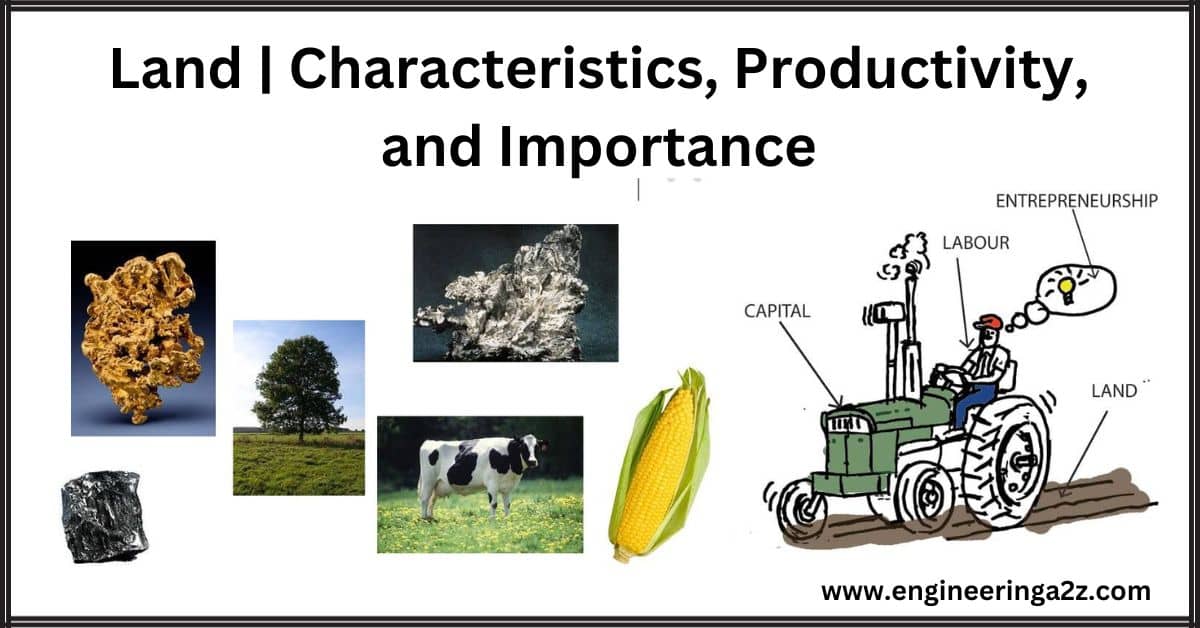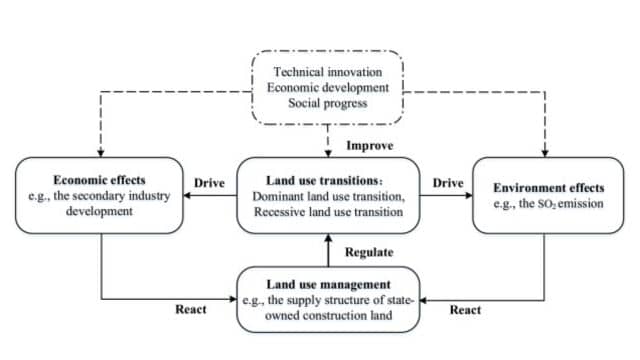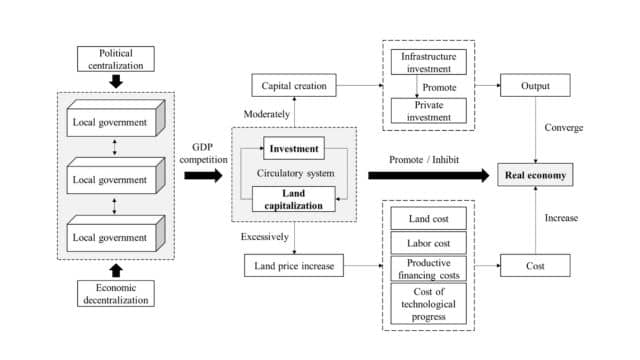
Table of Contents
Introduction
The soil we cultivate, the river water with which we irrigate our fields, the forests we get wood from, and the mines yielding coal and Iron, etc. are also provided to us by nature free of cost. All these trees are free of nature and form part of the Land. Undoubtedly, land is an important factor in production. The dictionary means that Land is the surface of the earth. But in Economics, the term land is used in a broad sense. All goods that are provided by nature free of cost and which yield income are called Land.
Definitions
The main definitions of land are as follows:
- According to Marshall, “By land is meant not merely land in the strict sense of the word the whole of the material and forces which nature gives freely for man’s aid land and water, in air and heat.”
- According to Cairncross, “All free gifts of nature that yield income, e.g. agricultural residential land, mines, fisheries, etc. are included in the land.” We exclude from land, sun shines, rainfall other natural resources because the same are not owned or possessed by any single individual.
- In the words of H.A. Smith, “Land applies to all those gifts of nature which man u providing the things that satisfy his wants.”
Characteristics of Land

The passage you’ve provided discusses various characteristics and aspects of land in economics. Here’s a summary of each point:
- Free Gift of Nature: Land is considered a free gift of nature to society, as it has no cost of production. This characteristic is often used to support the argument for the nationalization of land.
- Land is Limited: The supply of land is limited, and its total area on Earth is fixed. Unlike other factors of production, such as labor or capital, land cannot be increased or decreased in quantity.
- Land is Indestructible: Land cannot be destroyed or created. It retains its physical existence, even as its form and nature may change due to human activities.
- Land Differs in Variety: No two pieces of land are identical in terms of productivity and situation. Different regions may have varying soil types, fertility levels, and other characteristics.
- Land is a Passive Factor: Land, on its own, cannot produce anything. It requires human intervention and cultivation to become productive.
- Law of Diminishing Marginal Returns: The law of diminishing marginal returns applies to land, meaning that as more units of labor and capital are applied to a given area of land, the additional productivity (marginal productivity) tends to decrease. This concept has implications for agriculture and resource allocation.
- Effect of Situation: The price of land is influenced by its location or situation. Land located near towns and markets tends to have higher prices compared to land in more remote areas.
- Use of Land: The primary quality of land is its use. The right to use a piece of land at a given place provides control over it and access to natural elements like light, heat, and rainfall. Land use determines its utility and value.
These characteristics of land are important in economic analysis and have implications for various economic theories and policies, including those related to land ownership, resource allocation, and urban planning.
Productivity or Efficiency of Land
The productivity or efficiency of land is influenced by various factors, including natural, human, organizational, situational, and capital-related factors. Here’s a simplified summary:
- Natural Factors: Land productivity is affected by natural elements such as soil quality, climate, and chemical properties of the soil. For example, land with fertile soil and favorable climate tends to be more productive. Irrigation facilities can also enhance land productivity.
- Human Factor: The efforts and skills of farmers significantly impact land productivity. Hardworking and skilled farmers can achieve higher agricultural production. For instance, the hard work of farmers in Punjab and Haryana has contributed to increased agricultural output in these regions.
- Organization: Effective organization involves allocating labor, capital, and technology to the land. Competent organizations can optimize land productivity by utilizing different factors efficiently.
- Situation: The location of land can affect its productivity. Land near markets, cities, or easily accessible transportation tends to be more productive. For example, land near Delhi is often more productive than land in more remote areas like Ambala and Sangrur.
- Capital: Investment in land, such as the use of better seeds, chemical fertilizers, irrigation facilities, and machinery, can significantly boost land productivity. The Green Revolution in India is an example of the impact of capital investment on agriculture.
- Proper Land Use: Land productivity increases when it is used for the purpose it is best suited for. Using land for its optimal purpose ensures maximum productivity.
- Land Reforms: Land ownership and size play a crucial role in land productivity. When land is owned by those who cultivate it and is of an appropriate size, it encourages enthusiasm and investment in improving productivity. Land reforms in India, such as the abolition of the Zamindari System and landholding ceilings, aim to promote equitable land ownership and boost productivity.
Importance of Land
The land is the foundation of all production. Whether it’s growing cotton for textiles, harnessing hydro-electricity or thermal power, constructing roads and railways, or engaging in agriculture, industry, and transportation, land plays a central role in every aspect of economic activity. Here’s a concise breakdown of its importance:
- Basis of Primary Occupation: Primary occupations like agriculture, animal husbandry, forestry, and more rely heavily on land.
- Basis of Industries: Manufacturing industries depend on land for various raw materials, such as cotton, sugarcane, coal, and minerals.
- Basis of Power: All sources of power, including hydroelectricity, thermal power, and more, originate from land resources.
- Basis of Trade: Many traded products, like food, minerals, timber, leather, and agricultural goods, come directly from land-based resources.
- Basis of Transport: Land serves as the foundation for transportation modes like roads, railways, waterways, and airways, as they traverse the land’s surface, rivers, oceans, and air.
- Basis of Employment: In underdeveloped agricultural countries, a significant portion of the population finds employment in land-based activities like farming, forestry, and mining.
- Basis of Economic Growth: Natural resources, primarily land, play a vital role in a country’s economic development. For example, the prosperity of some Gulf countries is linked to oil wells, South Africa’s development is driven by gold mines, and fertile lands, irrigation, and power facilities contribute to the high per capita income in regions like Punjab and Haryana.
- Basis of Life: Land is essential for our survival, providing not only food but also a suitable climate for habitation.
In summary, in underdeveloped countries like India, where a large portion of the population relies on agriculture, land stands as the most crucial factor of production.

Methods of Cultivation Volume of production
Increasing the production of food grains depends on the factors of production: land, labor, and capital. There are two primary methods to achieve this:
- Extensive Cultivation: In this method, you can increase foodgrain production by expanding the amount of land used for cultivation while keeping the levels of labor and capital constant. This means bringing more land into agricultural use. This approach focuses on expanding the physical area dedicated to farming.
- Intensive Cultivation: Alternatively, you can increase food grain production by maximizing the efficiency and productivity of the existing land without necessarily expanding the land area. This involves increasing the units of labor and capital invested in farming while maintaining the same land size. It emphasizes optimizing the use of existing resources through techniques, technology, and investment.
Characteristics of Extensive Cultivation
- In this type of farming, less emphasis is placed on using labor and capital intensively.
- It is typically found in newly settled areas with a shortage of labor or in poor, underdeveloped countries.
- The focus is on bringing more land into cultivation to boost production.
- Output per hectare is lower, and the land is not optimally utilized.
- It is often considered an unscientific method of farming.
Characteristics of Intensive Cultivation
- Greater Use of Labor and Capital: Farmers rely more on labor and investment in tools, machinery, and modern techniques.
- Higher Productivity per Hectare: This method yields more output from each unit of land compared to extensive cultivation.
- Scientific Farming: It involves applying advanced and scientific approaches to farming, including the use of machinery, improved seeds, and fertilizers.
Frequently Asked Questions (FAQs)
What is land?
In economics, land refers to the natural resources, including physical surface area and subsoil assets, used in production. It encompasses all non-reproducible resources and plays a crucial role in production processes.
Is land an asset or capital?
Land is typically considered a distinct factor of production in economics and is not classified as either an asset or capital in the traditional sense. It is a natural resource that serves as one of the essential factors of production alongside labor and capital. However, in accounting and financial contexts, land is often categorized as a long-term asset on a company’s balance sheet.
What is the useful life of land?
Land has an indefinite useful life, as it doesn’t wear out or depreciate over time. It remains a perpetual asset, providing a foundation for various activities and uses.
Read Also:
- Marketing Management | Objectives & Functions of Marketing Management
- Total Quality Management | History, Importance, and Characteristics
- Energy Management | Need and Environmental Aspects
- Economics For Engineers Book PDF





Leave a Reply